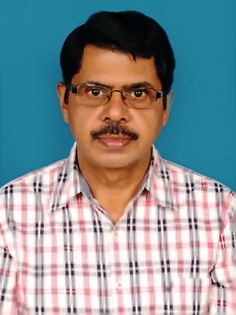Colloquium # 290
Like Likes Like: Experiments on Charged Colloids to Dusty Plasmas
By Prof. B.V.R. Tata
School of Physics, University of Hyderabad,
Gachibowli, Hyderabad-46, Telangana
Friday, Aug 17th 2018 at 3:30 PM
Seminar Hall

Abstract
Among the various soft matter systems, charge stabilized colloidal dispersions have gained recognition as an ideal model condensed matter system because of their structural ordering, dynamics and rich phase behavior. One of the most fascinating aspects of monodisperse charged colloidal dispersions is the appearance of long-range order at very dilute conditions (volume fraction \phi ~0.001). These ordered structures are popularly known as colloidal crystals/photonic crystals and found importance in fundamental studies as well as practical applications in a wide range of disciplines. Deionized suspensions of low charge density particles freeze into a homogenous crystalline or a glassy state depending on the volume fraction. However under high charge density and low salt conditions they can be inhomogeneous by exhibiting gas-liquid, gas-solid and re-entrant transitions, phase separation in the form of voids coexisting with ordered or disordered regions. These observations suggest existence of long-range attraction between like charged colloids and not understandable using purely repulsive screened Coulomb pair-potential. Recent observations such as existence of stable bound pairs, measured pair-potential U(r) showing an attractive minimum at several interparticle spacings, provide unambiguous evidence for the existence of long-range attraction between like charged particles. The homogenous and inhomogeneous phases observed in charged colloids have commonality with dusty plasmas. Though counterions are known to play important role in mediating the attraction between like charged particles in both the systems, the understanding on the origin of long-range-attraction is in complete and remained as an open problem. The talk address to some of these aspects by highlighting our own experimental observations on charged colloids and on a charged metal ball system.
About the speaker
Dr. B.V.R. Tata was an Outstanding Scientist at Indira Gandhi Centre for Atomic Research (IGCAR), Kalpakkam, India and was a Senior Professor of Homi Bhabha National institute (HBNI@IGCAR). He was also Head, Condensed Matter Physics Division (CMPD), Materials Science Group(MSG) at IGCAR, Kalpakkam.
After superannuating from IGCAR in June, 2016, Dr. Tata joined as a visiting Professor at Indian Institute of Physics (IIT)-Palakkad, Kerala.
Recently (March 2017) he was appointed as a Full Professor in Central University of Hyderabad (UOH) and currently establishing his research group in School of Physics, UOH, Hyderabad. Prof. Tata is from 25th Batch BARC-Training school and joined in IGCAR as scientific officer in the year 1982. He got his M.Sc (Physics) Degree from Andhra University (1977) and Ph. D Degree from University of Madras (1993).
He has carried out Post-doctoral studies at Central laboratory, Osaka (Japan) (1996-97) & Illinois Institute of Technology, Chicago, USA (1998).
Prof. Tata has received several Awards & Honors such as Distinguished Faculty Award, Homi Bhabha National Institute, Mumbai (2015), Award of Erudite Visiting Professor, Mahatma Gandhi University-Kottayam, Kerala (2011), Materials Research Society of India Medal in (2009), Young research award (1998), Kalpakkam Science & Technology Award (1993),Editorial board Member of Journal of Physics - PRAMANA since 2010.
He has published over 275 research papers in international journals and conferences. He has published 2 books.
He has earned high reputation both nationally and internationally for the original, elegant and impressive experiments in the areas of phase transitions in nanoparticle dispersions and stimuli-responsive nanogels, bio-colloids, Photonic Crystals and computer simulations. His research interests are in the areas of Soft condensed matter, Computer Simulations, Optics & Photonics.

